Home >Technology peripherals >AI >Explore training techniques for open-world test segments using self-training methods with dynamic prototyping extensions
Explore training techniques for open-world test segments using self-training methods with dynamic prototyping extensions
- WBOYWBOYWBOYWBOYWBOYWBOYWBOYWBOYWBOYWBOYWBOYWBOYWBforward
- 2023-09-13 14:17:10980browse
Improving the generalization ability of the model is an important basis for promoting the implementation of vision-based perception methods. Test-Time Training/Adaptation (Test-Time Training/Adaptation) generalizes the model to Unknown target domain data distribution segment. Existing TTT/TTA methods usually focus on improving test segment training performance under target domain data in the closed-loop world.
However, in many application scenarios, the target domain is easily contaminated by strong out-of-domain data (Strong OOD), such as data unrelated to semantic categories. This scenario is also known as Open World Test Segment Training (OWTTT). In this case, existing TTT/TTA usually forces the classification of strong out-of-domain data into known categories, thereby ultimately interfering with the ability to resolve weak out-of-domain data (Weak OOD) such as images affected by noise
Recently, South China University of Technology and the A*STAR team proposed the setting of open world test segment training for the first time, and launched corresponding training methods

- Paper: https://arxiv.org/abs/2308.09942
- Code: https://github.com/Yushu-Li/OWTTT
This paper first proposes a strong out-of-domain data sample filtering method with adaptive threshold to improve the robustness of the self-training TTT method in the open world. The method further proposes a method to characterize strong out-of-domain samples based on dynamically extended prototypes to improve the weak/strong out-of-domain data separation effect. Finally, self-training is constrained by distribution alignment
The method in this study achieved the best performance on 5 different OWTTT benchmarks, and opened up new directions for subsequent research on TTT. New directions for more robust TTT methods. This research has been accepted as an oral presentation paper at ICCV 2023
Introduction
Test segment training (TTT) can access the target domain only during the inference phase data and perform on-the-fly inference on test data with distribution shifts. The success of TTT has been demonstrated on a number of artificially selected synthetically corrupted target domain data. However, the capability boundaries of existing TTT methods have not been fully explored.
To promote TTT applications in open scenarios, the focus of research has shifted to investigating scenarios where TTT methods may fail. Many efforts have been made to develop stable and robust TTT methods in more realistic open-world environments. In this work, we delve into a common but overlooked open-world scenario, where the target domain may contain test data distributions drawn from significantly different environments, such as different semantic categories than the source domain, or simply random noise.
We call the above test data strong out-of-distribution data (strong OOD). What is called weak OOD data in this work is test data with distribution shifts, such as common synthetic damage. Therefore, the lack of existing work on this realistic environment motivates us to explore improving the robustness of Open World Test Segment Training (OWTTT), where the test data is contaminated by strong OOD samples.
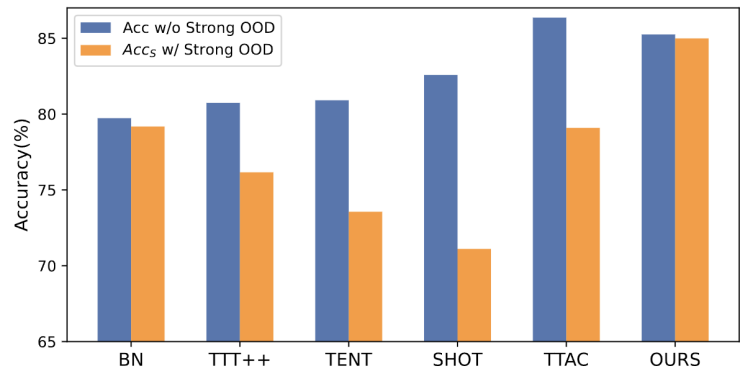
Figure 1: Evaluation results of the existing TTT method under OWTTT settings
As shown As shown in Figure 1, we first evaluate existing TTT methods under the OWTTT setting and find that TTT methods through self-training and distribution alignment will be affected by strong OOD samples. These results demonstrate that safe test-time training in the open world cannot be achieved by applying existing TTT techniques. We attribute their failure to the following two reasons.
- Self-training-based TTT has difficulty handling strong OOD samples because it must assign test samples to known classes. Although some low-confidence samples can be filtered out by applying the threshold employed in semi-supervised learning, there is still no guarantee that all strong OOD samples will be filtered out.
- Methods based on distribution alignment will be affected when strong OOD samples are calculated to estimate the target domain distribution. Both global distribution alignment [1] and class distribution alignment [2] can be affected and lead to inaccurate feature distribution alignment.
In order to solve the potential reasons for the failure of existing TTT methods, we propose a method that combines two technologies to improve the robustness of open-world TTT under a self-training framework.
First, we construct the baseline of TTT on the self-trained variant, that is, clustering in the target domain with the source domain prototype as the cluster center. To mitigate the impact of self-training on strong OOD with incorrect pseudo-labels, we design a hyperparameter-free method to reject strong OOD samples.
To further separate the characteristics of weak OOD samples and strong OOD samples, we allow the prototype pool to expand by selecting isolated strong OOD samples. Therefore, self-training will allow strong OOD samples to form tight clusters around the newly expanded strong OOD prototype. This will facilitate distribution alignment between source and target domains. We further propose to regularize self-training through global distribution alignment to reduce the risk of confirmation bias.
Finally, in order to synthesize the open-world TTT scenario, we use CIFAR10-C, CIFAR100-C, ImageNet-C, VisDA-C, ImageNet-R, Tiny-ImageNet, MNIST and SVHN dataset, and establish a benchmark dataset by utilizing one dataset as weak OOD and the other as strong OOD. We refer to this benchmark as the Open World Test Segment Training Benchmark and hope that this encourages more future work to focus on the robustness of test segment training in more realistic scenarios.
Method
The paper divides the proposed method into four parts to introduce it
1) Overview of the settings of the training tasks in the test segment under the open world.
#2) Describes how to implement TTT by rewriting the content as: cluster analysis and how to extend the prototype for open world test-time training.
3) Introduces how to use target domain data for dynamic prototype expansion.
4) Introduce Distribution alignment combined with rewritten content: cluster analysis to achieve powerful open-world test-time training.
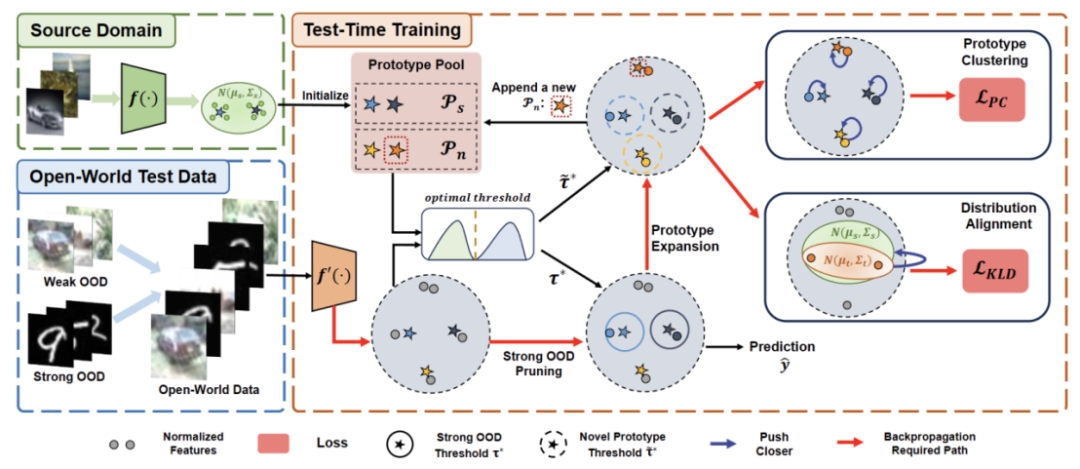
Figure 2: Method overview diagram
Task setting
The purpose of TTT is to adapt the source domain pre-trained model to the target domain, where the target domain may have distributed migration relative to the source domain. In standard closed-world TTT, the label spaces of the source and target domains are the same. However, in the open world TTT, the label space of the target domain contains the target space of the source domain, which means that the target domain has unseen new semantic categories
In order to avoid the gap between TTT definitions For confusion, we adopt the sequential test time training (sTTT) protocol proposed in TTAC [2] for evaluation. Under the sTTT protocol, test samples are tested sequentially, and model updates are performed after observing small batches of test samples. The prediction for any test sample arriving at timestamp t is not affected by any test sample arriving at t k (whose k is greater than 0).
Rewritten content as: Cluster analysis
Inspired by work using clustering in domain adaptation tasks [ 3, 4], we treat test segment training as discovering cluster structures in the target domain data. By identifying representative prototypes as cluster centers, cluster structures are identified in the target domain and test samples are encouraged to embed near one of the prototypes. The rewritten content is: The goal of cluster analysis is defined as minimizing the negative log-likelihood loss of the cosine similarity between the sample and the cluster center, as shown in the following formula.

We developed a hyperparameter-free method to filter out strong OOD samples to avoid the negative impact of adjusting model weights. Specifically, we define a strong OOD score os for each test sample as the highest similarity to the source domain prototype, as shown in the following equation.

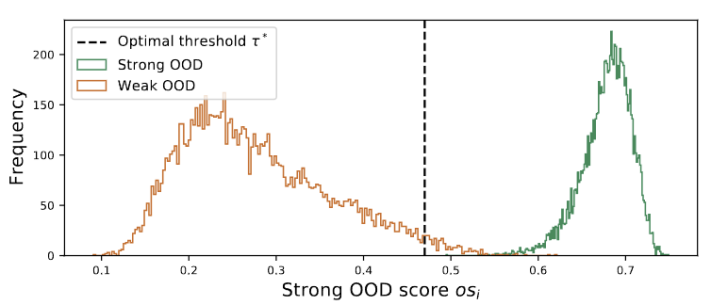
Figure 3 Outliers present a bimodal distribution
We observe that the outliers follow a bimodal distribution, as shown in Figure 3. Therefore, instead of specifying a fixed threshold, we define the optimal threshold as the best value that separates the two distributions. Specifically, the problem can be formulated as dividing the outliers into two clusters, and the optimal threshold will minimize the within-cluster variance in . Optimizing the following equation can be efficiently achieved by exhaustively searching all possible thresholds from 0 to 1 in steps of 0.01.

Dynamic prototype expansion
Expanding the strong OOD prototype pool needs to be considered at the same time Source domain and strong OOD prototypes to evaluate test samples. To dynamically estimate the number of clusters from data, previous studies have investigated similar problems. The deterministic hard clustering algorithm DP-means [5] was developed by measuring the distance of data points to known cluster centers, and a new cluster is initialized when the distance is above a threshold. DP-means is shown to be equivalent to optimizing the K-means objective but with an additional penalty on the number of clusters, providing a feasible solution for dynamic prototype expansion.
To alleviate the difficulty of estimating additional hyperparameters, we first define a test sample with an extended strong OOD score as the closest distance to the existing source domain prototype and the strong OOD prototype, As follows. Therefore, testing samples above this threshold will build a new prototype. To avoid adding nearby test samples, we incrementally repeat this prototype expansion process.

As other strong OOD prototypes are identified, we define the rewrite for the test sample as: cluster analysis loss, and consider two factors. First, test samples classified into known classes should be embedded closer to prototypes and farther away from other prototypes, which defines the K-class classification task. Second, test samples classified as strong OOD prototypes should be far away from any source domain prototypes, which defines the K 1 class classification task. With these goals in mind, we will rewrite the content as: The cluster analysis loss is defined as follows.

Distributed alignment constraints mean that elements in a design or layout are required to be arranged and aligned in a specific way. This constraint can be applied to a variety of different scenarios, including web design, graphic design, and space layout. By using distributed alignment constraints, the relationship between elements can be made clearer and more unified, improving the aesthetics and readability of the overall design
It is well known that self-training is susceptible to errors The impact of pseudo-labeling. The situation is worsened when the target domain consists of OOD samples. To reduce the risk of failure, we further use distribution alignment [1] as a regularization for self-training, as follows.

Experiments
We tested on 5 different OWTTT benchmark datasets, including Synthetically corrupted datasets and style-varying datasets. The experiment mainly uses three evaluation indicators: weak OOD classification accuracy ACCS, strong OOD classification accuracy ACCN and the harmonic mean of the two ACCH

# #The content that needs to be rewritten is: Cifar10-C The performance of different methods in the data set is shown in the table below

The content that needs to be rewritten is: Cifar100 The performance of different methods in the -C data set is shown in the following table:
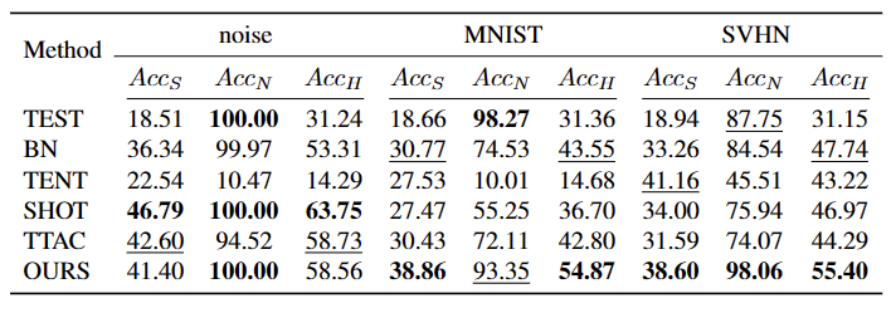
The content that needs to be rewritten is: on the ImageNet-C data set, different The performance of the method is shown in the following table

Table 4 Performance of different methods on the ImageNet-R data set
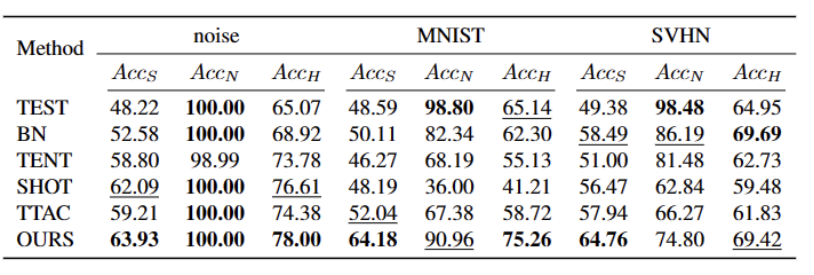
Table 5 The performance of different methods on the VisDA-C data set
Our method has significantly improved compared to the current best methods on almost all data sets, as shown in the table above . It can effectively identify strong OOD samples and reduce the impact on the classification of weak OOD samples. Therefore, in an open world scenario, our method can achieve a more robust TTT
Summary
This paper proposes an open world for the first time Problems and settings of test segment training (OWTTT), pointing out that existing methods will encounter difficulties when processing target domain data containing strong OOD samples that have semantic offsets from source domain samples, and proposes a dynamic prototype extension-based The self-training method solves the above problems. We hope that this work can provide new directions for subsequent research on TTT to explore more robust TTT methods
The above is the detailed content of Explore training techniques for open-world test segments using self-training methods with dynamic prototyping extensions. For more information, please follow other related articles on the PHP Chinese website!
Related articles
See more- How to use PHP unit testing framework PHPUnit
- what is java unit testing
- PHP 8 is here! PHP team releases first beta version Alpha1
- The first government review of ChatGPT may come from the US Federal Trade Commission, OpenAI: not yet trained GPT5
- Zoom ensures transparency in data usage and ensures AI training is subject to user permission

